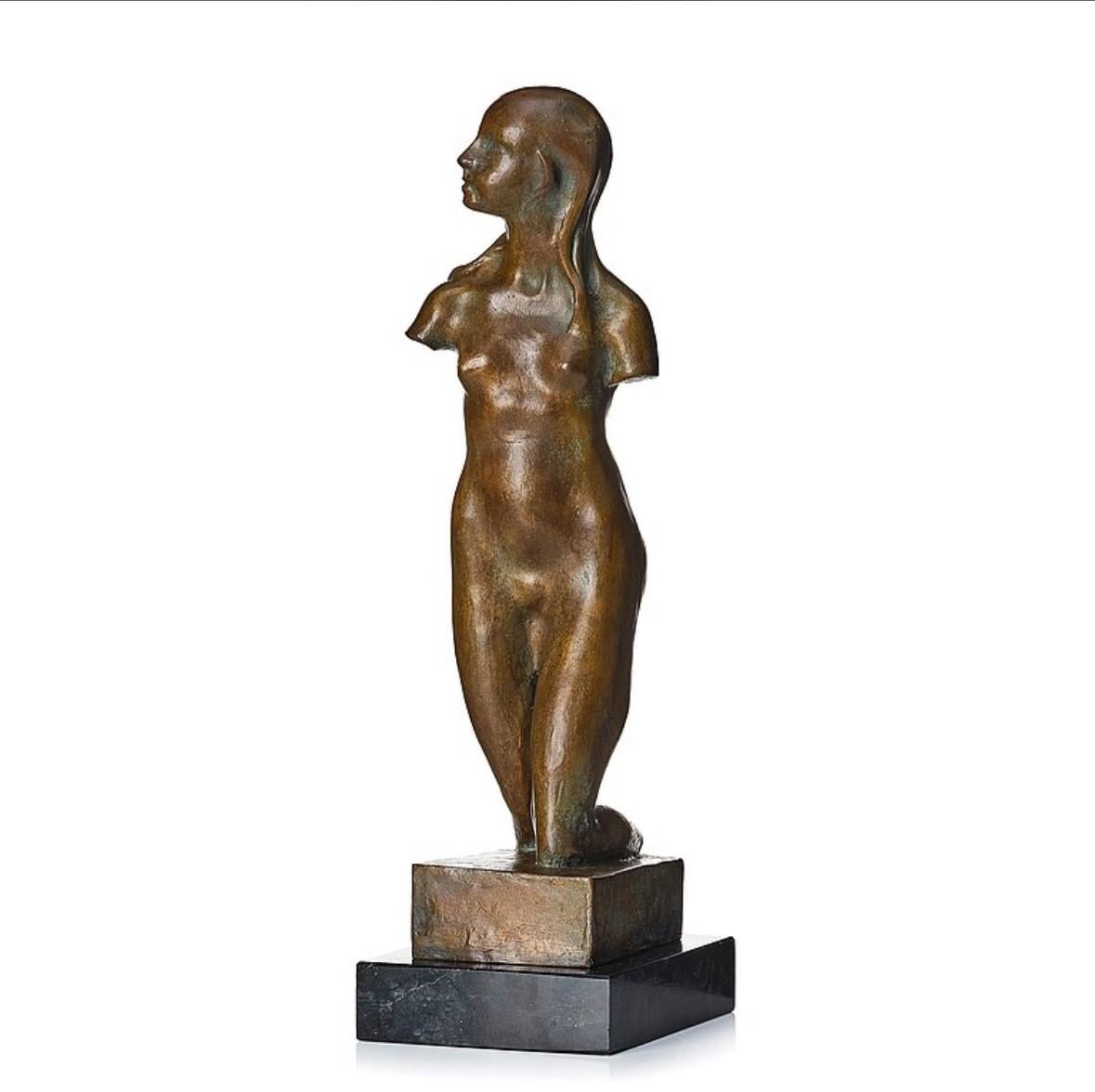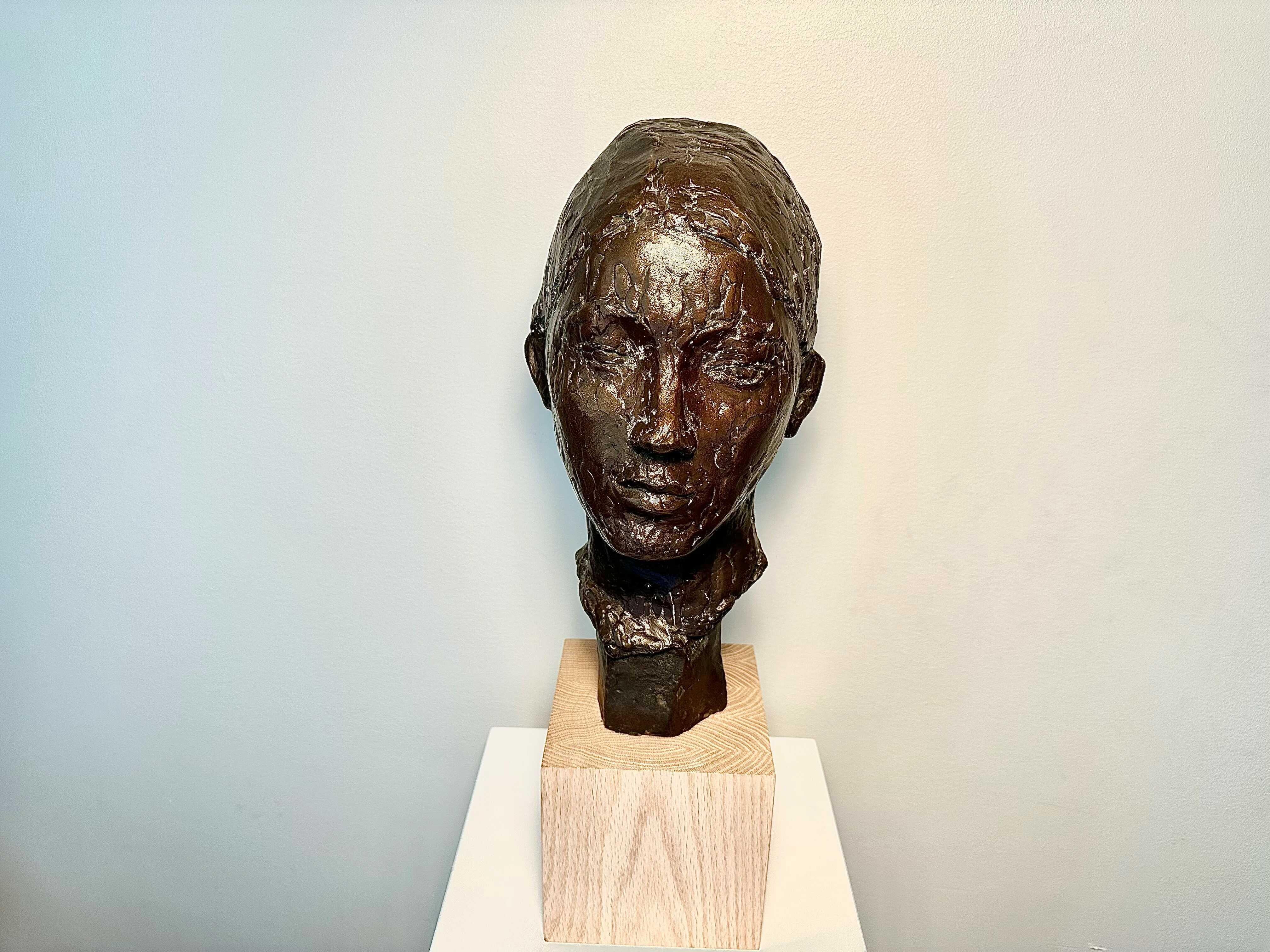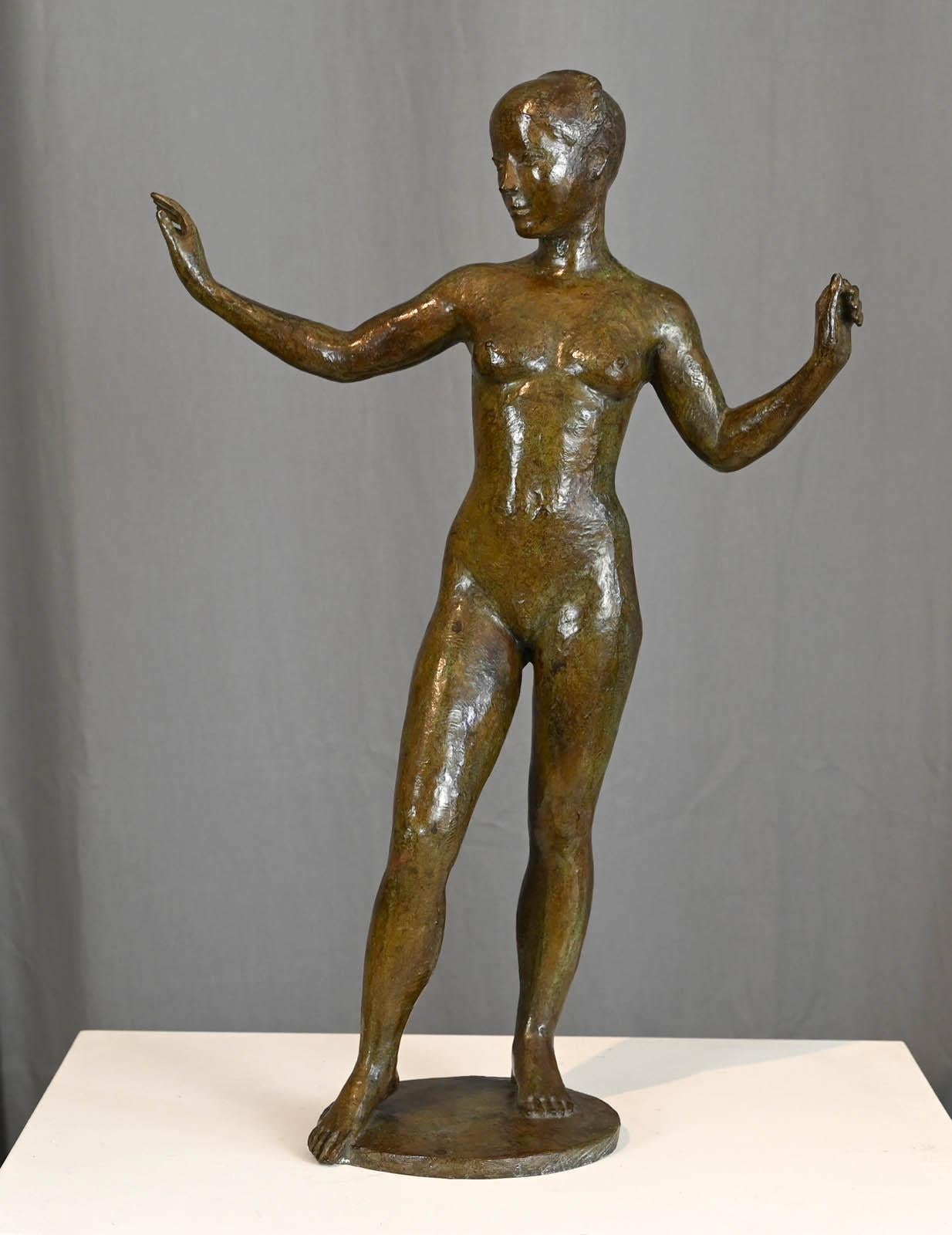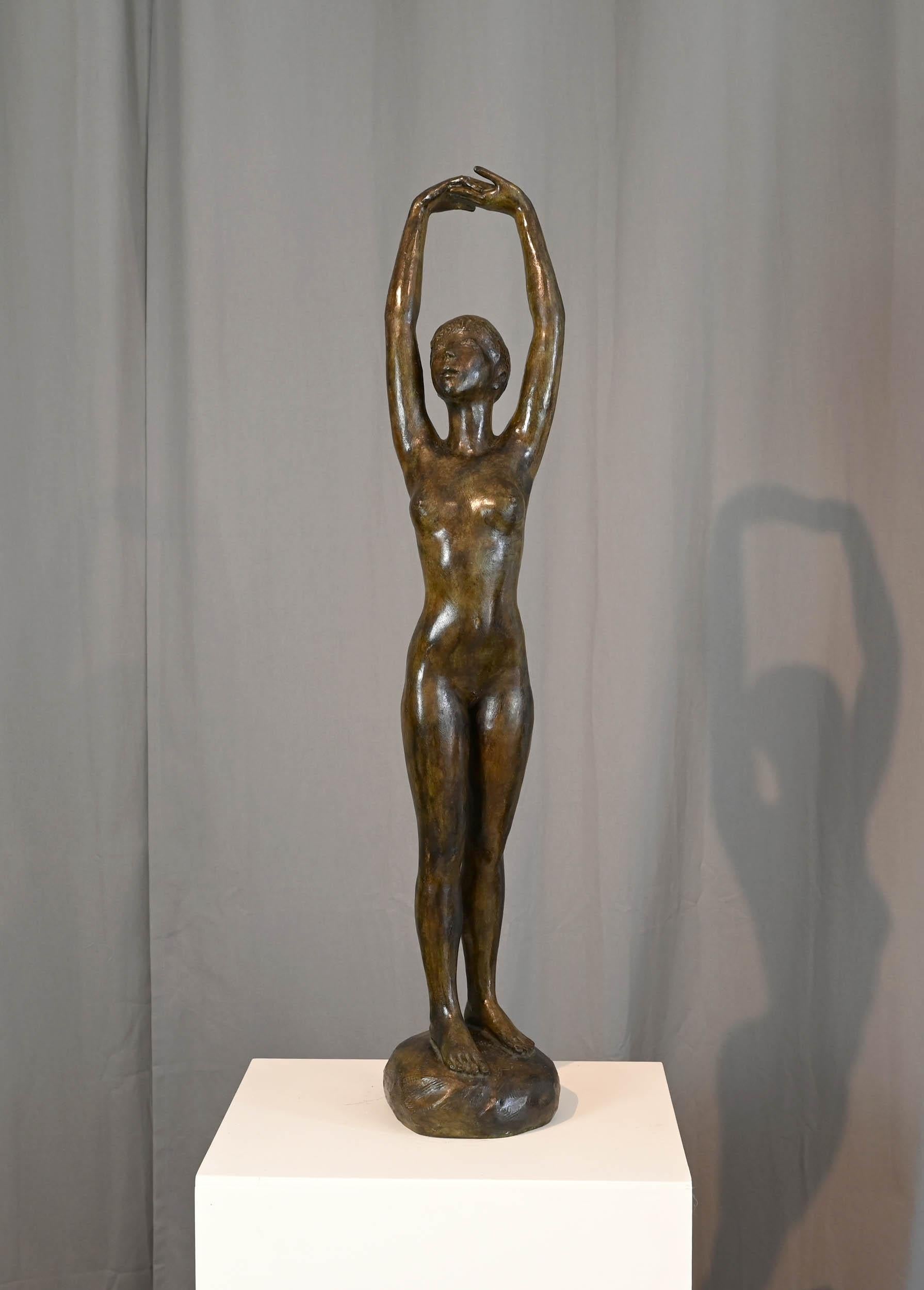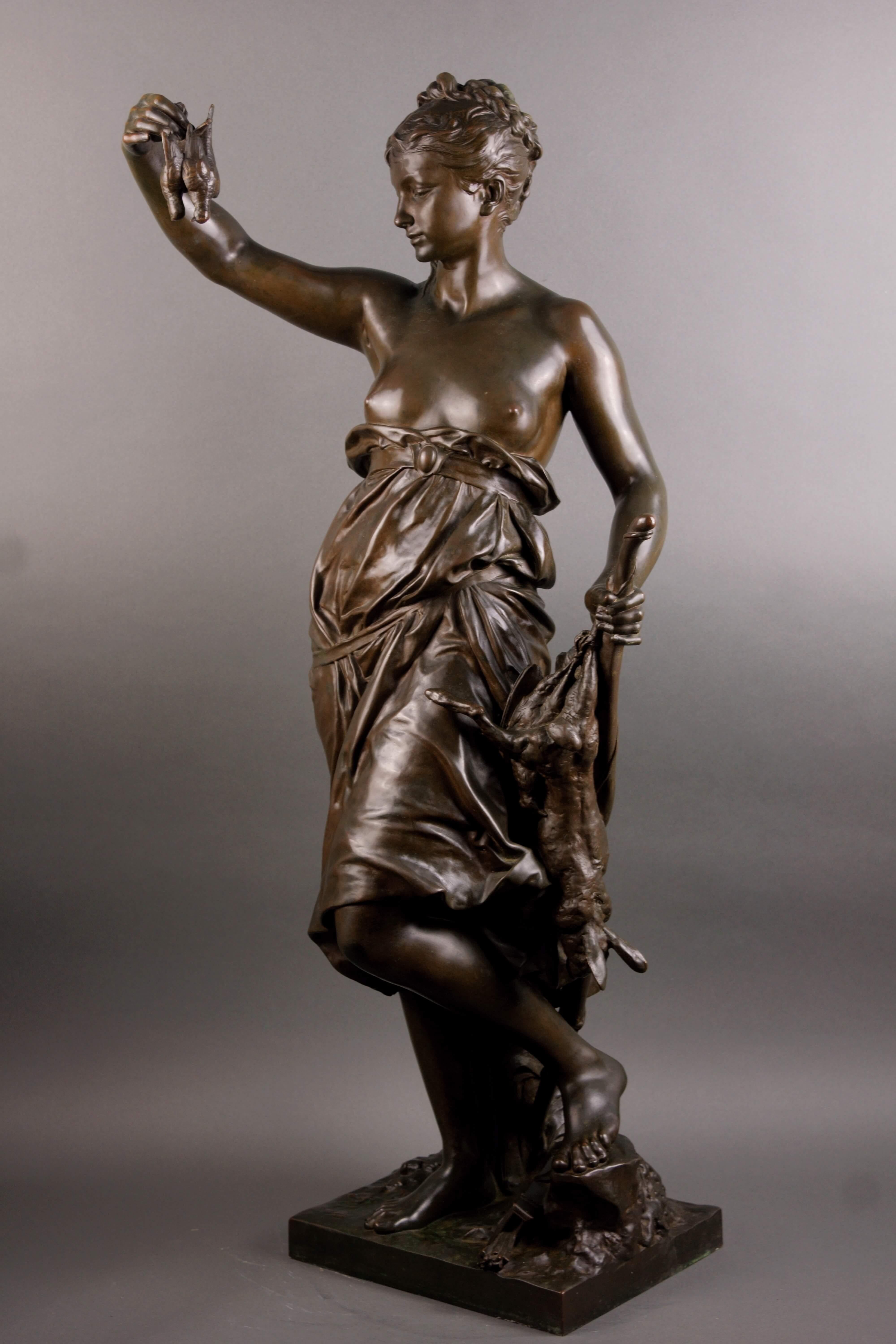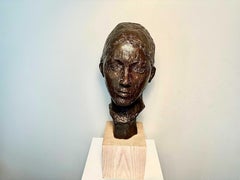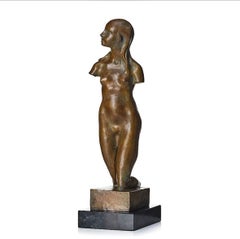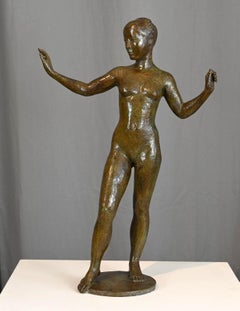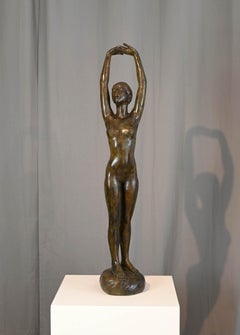Objekte ähnlich wie Centaur abducting a woman
Möchten Sie mehr Bilder oder Videos?
Zusätzliche Bilder oder Videos von dem*der Anbieter*in anfordern
1 von 15
Aimé-Jules DalouCentaur abducting a womancirca 1895-1902
circa 1895-1902
Angaben zum Objekt
Centaur abducting a woman
by Aimé-Jules DALOU (1838-1902)
A bronze group sculpture with a dark brown patina
Signed on the base "Dalou"
Cast by "A.A. Hébrard" (with the foundry stamp)
The casts by Hébrard are always the finest ones regarding Dalou's works. Perfect in quality of cast and patina.
France
posthumous cast around 1910
height 27 cm
width 21 cm
depth 15,5 cm
A similar model reproduced in "Jules Dalou, le sculpteur de la République", Exhibition held at the Musée du Petit Palais, Paris, 2013, page 415, n°337.
Biography :
Aimé-Jules Dalou, said Jules Dalou (1838-1902) was a French sculptor, born from Protestants glovers craftsmen who raised in secularism and love of the Republic. Jules Dalou was very young talented for modeling and drawing, which earned him the attention of Jean-Baptiste Carpeaux, who made him entered in 1852 in the Little School, the future National School of Decorative Arts in Paris. In 1854, he was admitted to the School of Fine Arts in Paris, where he studied painting in the workshop of Abel de Pujol and sculpture in the workshop of Francisque Duret. He began to earn his living by working for decorators, and began his friendship with Auguste Rodin. Dalou then produced decorative sculptures for buildings on major Parisian avenues, such as the Hotel de la Paiva, on the Champs-Elysees Avenue. He presented but failed four times to Rome prize competition, but exhibited at the 1869 Salon his "Daphnis and Chloe" and the "Embroiderer" at the Salon of 1870, two pieces acquired by the French state. Dalou had one child, Georgette, a girl born with a mental handicap. This is to ensure funding for her daughter's life accommodation in the Orphanage of Arts, that Dalou bequeathed the funds from his workshop to this institution.
After the bloody week of May 1871 Dalou, his wife and their daughter were threatened as Communards, forced into exile and requested asylum. They then joined England and were greeted by his former fellows of the Little School, the painter Alphonse Legros. With Legros, much introduced in the City, he made a serie of terracotta statuettes inspired by boulonnaise peasants or intimate subjects (readers, lullabies), and portraits of the English aristocracy. He became professor for modeling at the National Art Training School, his influence was decisive for many British sculptors. He received orders for a public fountain in marble titled "Charity" (1877) near the Royal Exchange in London, and a monument dedicated to Queen Victoria's grandchildren located in the private chapel of Frogmore at Windsor Castle.
In May 1874, the Paris War Council condemned Dalou in absentia to hard labor for life. Having refused to beg for mercy, he was only in May 1879 being granted amnesty and his family finally returned from exile. His group "The Triumph of the Republic", originally planned for the Place de la Republique in Paris, was finally erected on the Place du Trône, renamed Place de La Nation in 1880. Dalou devoted twenty years to the realization of this monument. The years 1881 and 1882 were difficult, but the 1883 Salon finally revealed him to the French public. He exhibited his two high reliefs: "The Brotherhood of Peoples" and "Mirabeau answering Dreux-Brézé", for which he was awarded the Medal of Honor. Fleeing the world and living in family, Dalou engaged in considerable work and many orders both private and public. For the Universal Exhibition of 1889, was inaugurated on the Place de la Nation the plaster of "The Triumph of the Republic" commissioned by the city of Paris in 1879. Although the bronze version of the group was inaugurated in 1899, this work won the grand prize for sculpture in the exhibition. Dalou left the French Society of Artists in 1890 to expose at the National Society of Fine Arts, of which he was a founding member with Ernest Meissonier, Auguste Rodin and Pierre Puvis de Chavannes. Awarded Knight of the Legion of Honor in 1883, and promoted to officer by President Carnot in 1889, he was elevated to the rank of Commander of the same order in 1899 by President Loubet at the inauguration of the monument of "The Triumph of the Republic".
Dalou had no time to complete his last great project, a monument dedicated to workers, the idea came to him in 1889 after the first opening of "TheTriumph of the Republic". The formality of the ceremony and military parades held the people away from the official event. Dalou was disappointed. True to its republican ideals, he had hoped that this inauguration was an opportunity of great popular democratic party (as it was at the inauguration of the bronze in 1899). His idea was then to pay tribute to the world of workers, craftsmen and peasants with this work being the central subject. At the end of his career Dalou described the project as follows: "I think I have finally found the monument to the workers that I seek since 1889. Sober, without molding or ornament, I wish it'd be severe and imposing. Will I execute it? There is the question. I am old and my health is so weak."
- Schöpfer*in:Aimé-Jules Dalou (1838 - 1902, Französisch)
- Entstehungsjahr:circa 1895-1902
- Maße:Höhe: 27 cm (10,63 in)Breite: 21 cm (8,27 in)Tiefe: 15,5 cm (6,11 in)
- Medium:
- Bewegung und Stil:
- Zeitalter:
- Zustand:
- Galeriestandort:PARIS, FR
- Referenznummer:Anbieter*in: N.X1stDibs: LU2514216390642
Anbieterinformationen
5,0
Anerkannte Anbieter*innen
Diese renommierten Anbieter*innen sind führend in der Branche und repräsentieren die höchste Klasse in Sachen Qualität und Design.
Gründungsjahr 1992
1stDibs-Anbieter*in seit 2023
7 Verkäufe auf 1stDibs
Typische Antwortzeit: 14 Stunde
- VersandAngebot wird abgerufen …Versand von: PARIS, Frankreich
- Rückgabebedingungen
Einige Inhalte dieser Seite wurden automatisch übersetzt. Daher kann 1stDibs nicht die Richtigkeit der Übersetzungen garantieren. Englisch ist die Standardsprache dieser Website.
Authentizitätsgarantie
Im unwahrscheinlichen Fall eines Problems mit der Echtheit eines Objekts kontaktieren Sie uns bitte innerhalb von 1 Jahr für eine volle Rückerstattung. DetailsGeld-Zurück-Garantie
Wenn Ihr Objekt nicht der Beschreibung entspricht, beim Transport beschädigt wurde oder nicht ankommt, kontaktieren Sie uns bitte innerhalb von 7 Tagen für eine vollständige Rückerstattung. DetailsStornierung innerhalb von 24 Stunden
Sie können Ihren Kauf jederzeit innerhalb von 24 Stunden stornieren, ohne jegliche Gründe dafür angeben zu müssen.Geprüfte Anbieter*innen
Unsere Anbieter*innen unterliegen strengen Dienstleistungs- und Qualitätsstandards, wodurch wir die Seriosität unserer Angebote gewährleisten können.Preisgarantie
Wenn Sie feststellen, dass ein*e Anbieter*in dasselbe Objekt anderswo zu einem niedrigeren Preis anbietet, werden wir den Preis entsprechend anpassen.Zuverlässige weltweite Lieferung
Unsere erstklassigen Versandunternehmen bieten spezielle Versandoptionen weltweit, einschließlich individueller Lieferung.Mehr von diesem*dieser Anbieter*in
Alle anzeigenAmor und Psyche
Von Albert-Ernest Carrier-Belleuse
Amor und Psyche
von Albert-Ernest CARRIER-BELLEUSE (1824-1887)
Bronzegruppe mit nuancierter brauner Patina
signiert auf dem Sockel "Carrier-Belleuse".
alte Ausgabe gegossen
Frankr...
Kategorie
Spätes 19. Jahrhundert, Französische Schule, Figurative Skulpturen
Materialien
Bronze
Der Geburtsstunde der Venus
Von Albert-Ernest Carrier-Belleuse
Der Geburtsstunde der Venus
von Albert-Ernest CARRIER-BELLEUSE (1824-1887)
Bronzeskulptur mit doppelter Patina, nuanciert dunkelbraun und vergoldete Patina
unterzeichnet "A. Carrie...
Kategorie
1870er, Französische Schule, Figurative Skulpturen
Materialien
Bronze
Türkisches Pferd
Von Antoine-Louis Barye
Türkisches Pferd
von Antoine-Louis Barye (1796-1875)
"Cheval turc, antérieur gauche levé, terrasse carrée"
Bronzeskulptur mit nuancierter dunkelbrauner Patina
Signiert " Barye " auf...
Kategorie
Spätes 19. Jahrhundert, Französische Schule, Figurative Skulpturen
Materialien
Bronze
Löwin Drehen
Löwin Drehen
von Roger GODCHAUX (1878-1958)
Eine sehr schöne Bronzeskulptur mit nuancierter grünlich-dunkelbrauner Patina
Signiert " Roger Godchaux " auf dem Sockel
Gegossen von "S...
Kategorie
1930er, Französische Schule, Figurative Skulpturen
Materialien
Bronze
Plakette Weißwedelhirsch
Von Antoine-Louis Barye
Weißwedelhirsch
von Antoine-Louis BARYE (1796-1875)
Galvanische Bronzeplakette mit brauner Patina
Gezeichnet "Barye"
Zeitgenössischer Abguss aus der "Barye-Werkstatt" (hergestellt z...
Kategorie
1870er, Französische Schule, Figurative Skulpturen
Materialien
Bronze
Liebkosung der Liebe
Von Albert-Ernest Carrier-Belleuse
"Liebkosung der Liebe"
von Albert-Ernest CARRIER-BELLEUSE (1824-1887)
Bronzeskulptur mit nuancierter dunkelbrauner Patina
Signiert auf der Rückseite "A. Carrier-Belleuse"
Steht auf...
Kategorie
1870er, Französische Schule, Figurative Skulpturen
Materialien
Bronze
Das könnte Ihnen auch gefallen
Unbekannte Frau
Inspiriert durch den Kopf des Apollo von Antoine Bourdelle. Eine Frau mit starkem, festem und dennoch verletzlichem Ausdruck.
Kategorie
1980er, Französische Schule, Figurative Skulpturen
Materialien
Bronze
4.248 $
Weiblicher Torso
Dieser weibliche Torso steht für die Stärke und Verletzlichkeit der jungen Frau. Es wurde in den 70er Jahren entworfen und ist mit den Initialen de...
Kategorie
1950er, Französische Schule, Aktskulpturen
Materialien
Bronze
Marie
Jacques COQUILLAY (geboren 1935)
Marie
Original Bronze
Größe: 56x39x17cm
Exemplar Nr. 4/8
Signatur und Nummerierung auf dem Sockel.
Original-Bronze, hergestellt mit "verlorenem Wa...
Kategorie
Anfang der 2000er, Französische Schule, Aktskulpturen
Materialien
Bronze
9.310 $
Victoire
Jacques COQUILLAY (geboren 1935)
Victoire
Original Bronze
Größe: 105 x 22 x 20 cm
Exemplar Nr. 1/8
Signatur und Nummerierung auf dem Sockel.
Original-Bronze, hergestellt mit "verl...
Kategorie
Anfang der 2000er, Französische Schule, Aktskulpturen
Materialien
Bronze
12.802 $
venus und Liebe" SUSSE Fréres Gießerei Französische Bronzegruppe Mitte des 19
Jean BULIO (1827-1911), "Venus und Liebe", Bronzegruppe mit Medaillenpatina, signiert auf dem Sockel.
Auf der Rückseite ist die Gießereimarke von Susse Frères eingraviert.
Ausgeze...
Kategorie
Mid-19th Century, Französische Schule, Figurative Skulpturen
Materialien
Bronze
Französische Skulptur aus dem 19. Jahrhundert Patinierte Bronze und vergoldetes Barbedienne Fondeur
Von Jean-Baptiste Clésinger
"Helena von Troja", große Bronzeskulptur mit brauner Patina, signiert auf dem Sockel J. Clesinger-Rom 1864 - F. Barbedienne Gießer und mit dem mechanischen Reduktionssiegel von Colla...
Kategorie
1860s, Französische Schule, Figurative Skulpturen
Materialien
Bronze
